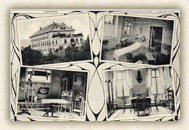|
|
|
|
|
|
|
|
|
|
 |
|
 |
|
 |
|
 |
|
|
Mestni trg (Town Square) with Town Hall (1484) on the right side and the Robba fountain (1751) in front of it. The sculptor Francesco Robba (1698-1757) was born in Venice. |
|
A bird’s-eye view at the Mestni trg and towards the cathedral (18th century) with a tramway in the forefront. |
|
Prešernov trg with Prešeren's monument (1905). Left from the seat of the Assicurazione Generale is the commercial Trubarjeva cesta, on the right the river Ljubljanica. France Prešeren (1800-1849) is the most significant Slovene poet and a symbol of Slovene identity. |
|
Prešernov trg in the direction of the Franciscan church of Mary’s Annunciation (from the middle of the 17th century). In the background – right from the church – stands the Art Nouveau hotel Union (1905). In the forefront of the picture postcard is an ice-cream man. |
|
| |
|
|
|
|
|
|
|
|
| |
 |
|
 |
|
 |
|
 |
|
| |
Part of the Ljubljana market-place at Pogačarjev trg in the immediate neighbourhood of the cathedral (right) and the Franciscan monastery (in the background). |
|
The town gained a tramway in 1901. In the picture postcard is one of the first trolley cars at Ambrožev trg. Since 1863, cabmen (fijakarji) had been transporting people around the town; at the turn of the 19th century, there were more and more cyclists, and a few automobiles were speeding through the streets of Ljubljana. |
|
Ljubljana is a town of squares. At Kongresni trg the baroque Ursuline church with the convent stands proudly. The camera always attracted numerous curious people. |
|
The provincial manor and seat of the Carniolian provincial assembly at Kongresni trg (1902), today the seat of the Ljubljana Universtiy. |
|
| |
|
|
|
|
|
|
|
|
| |
 |
|
 |
|
 |
|
 |
|
| |
The building opposite the Ursuline church is today the seat of the Slovene Philharmonic society, which has its roots in the year 1701. |
|
Ljubljana was also an educational centre. The building of the imperial-king’s trade school was built in 1911. |
|
In 1888, the building of the Provincial museum, today National museum, was solemnly opened at Muzejski trg in Ljubljana. In the forefront is the monument to the historian Janez Vajkard Valvasor (1641-1693). |
|
Ljubljana Tivoli: the green lungs of the town. In the background is the Tivoli palace, built in 1713. |
|
| |
|
|
|
|
|
|
|
|
| |
 |
|
 |
|
|
|
|
|
| |
View towards the hospital part of the town at the beginning of Zaloška cesta. |
|
Within the Ljubljana hospitals functioned the sanatorium Leonišče (1893), one of the most modern health institutions of that time in Ljubljana. |
|
|
|
|
|


















